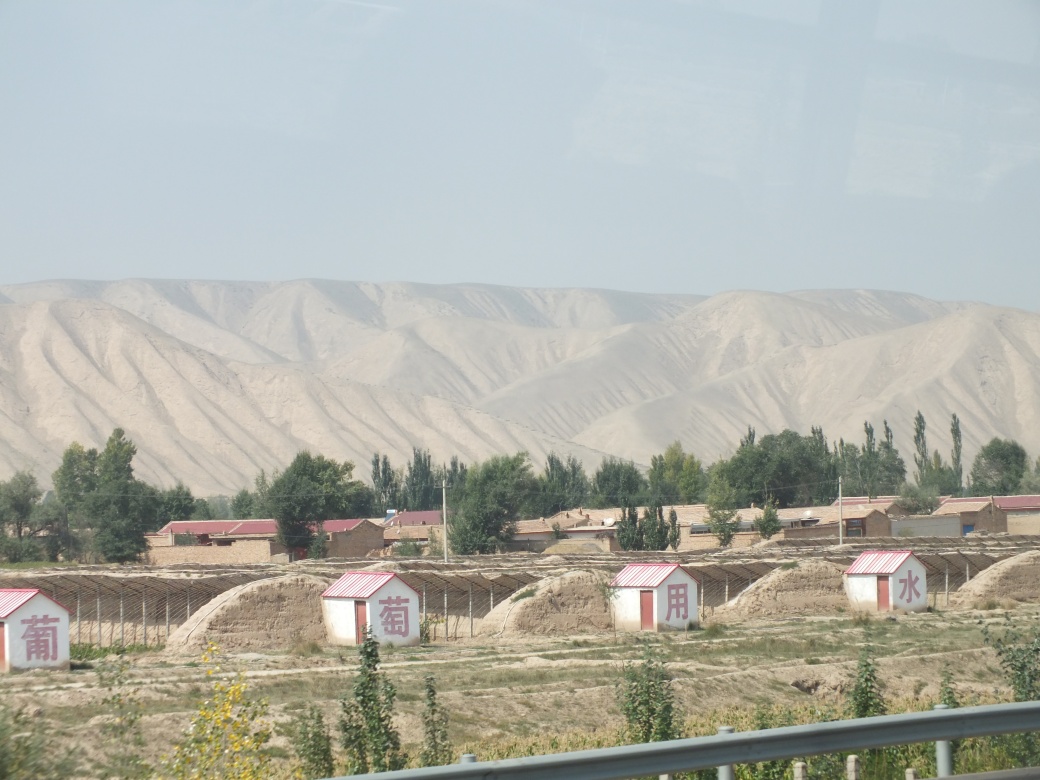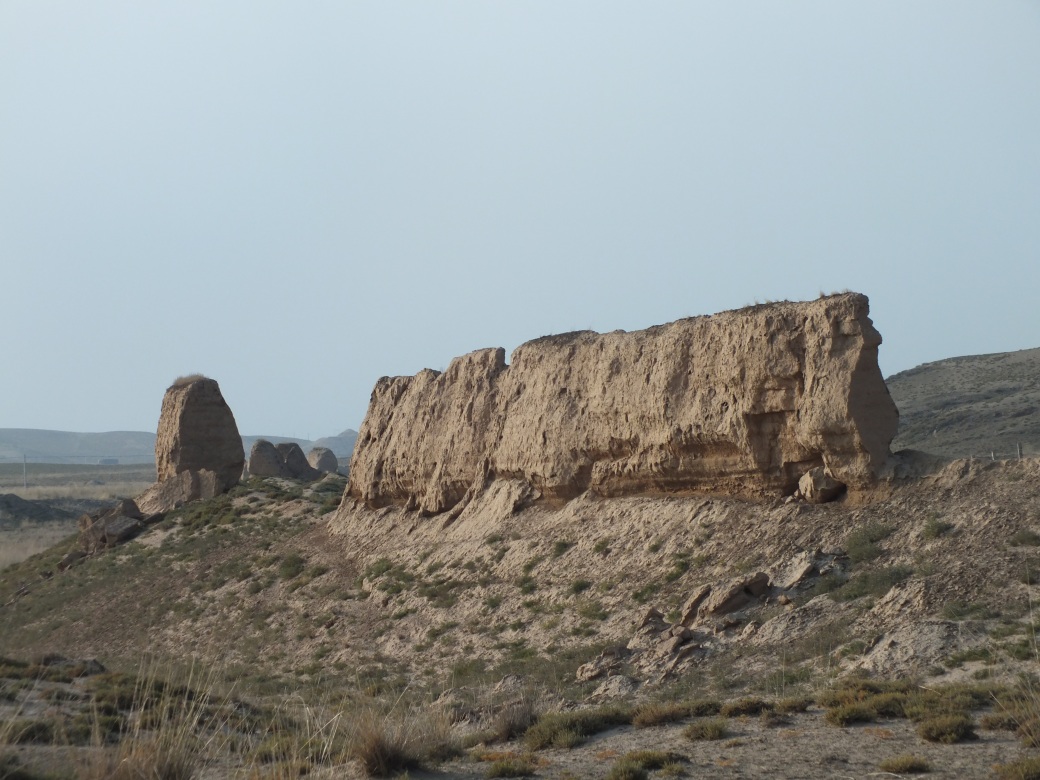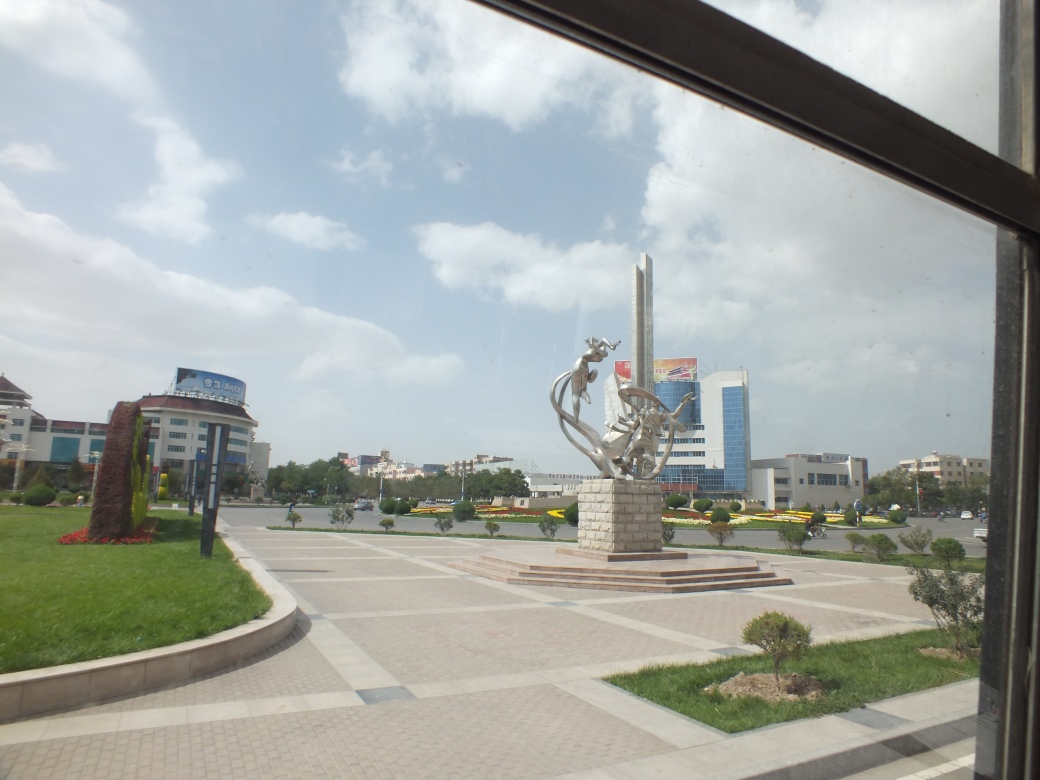Bingling Si Buddhist Caves
Leaving Xiahe, we head back north on the same tortuous road, but sidetrack over some high hills overlooking a lake-like widening of the Yellow river. We will cross the river by small boat through some spectacular scenery to reach the Bingling Si Caves.




Bingling Si is a fabulous Buddhist grotto site along the Yellow River – the
site is full of carvings and Buddhist artwork, including the centrepiece
Maitreya Buddha statue, a 27m-tall statue dug into the cliff.


Construction of the grottoes began in 420 CE and continued until the 15th Century. There are over 180 small caves and nearly 700 statues on the site (not all of which are open to the public), that are well preserved despite centuries of damage from erosion and earthquakes. For some reason I do not have shots of the dozens we visited- maybe photos were prohibited. Anyway, the statues tended to the repetitive, each probably the contribution of various devotees over the centuries.
 Mid-visit we stopped at local shrine for tea with its resident monks.
Mid-visit we stopped at local shrine for tea with its resident monks.

The shrine was adorned with statues and other artifacts.


In the early afternoon sun we headed back across the lake and over the hills to the main road on our way to Luijiaxia, a small town on the Yellow.



Our hotel in Luijiaxia was quite modest, usual standard. We quickly began to rate hotels based on whether there was any hot water. Usually not. I think Dragoman was paying something like $30-40 per room, shared by two of us. Later Jody discovered that in fact the Chinese tour company that provided our guide was charging us a premium on top of the hotel charge- which led to a great confrontation later in the trip. In some hotels we noticed the staff ran about furiously before we were allowed into our rooms- they were removing all the frills, like soap, towels, emptying the mini-fridges, etc., maximizing profit.

Our hotel sat on the banks of the Yellow, which looks more like Brown, near a major dam.

In the evening we crossed the river to the town centre, which was pleasantly attractive. We headed for the thriving market to buy supplies for our first rough camping adventure the next night. Our travel group was divided into teams of 3 or 4, with various housekeeping duties rotated among them. My group- Kelly, Susan, Gordon maybe, not sure- were responsible for cooking at camp, so we loaded up on fine vegetables for a ratatouille for dinner and eggs and stuff for breakfast. We had fun interacting with the locals in the market, including a small girl who insisted on practicing English, then a photo with her family. Shopping successful, we had a great dinner of dumplings in a small restaurant on the way back to the hotel.
Worth mentioning that breakfast was provided by most hotels, and was usually good basic stuff- rice, vegetables, boiled eggs, maybe some fruit. I remember the buffet breakfast here was pretty good. That was one of the expendables in the cheapskate hotels. In which case I would indulge in street food or local popular restaurants: fried bread sticks and such. For lunch we typically picked a truck-stop along the superhighway, ideally one with a decent store and toilet. Hot water was available to prepare ramen, and instant coffee or cafe au lait, that was quite good. There would be canned stuff and lots of snacks. Some of the stops, tho, were terribly grim.
At one stop there was no hot water for my coffee. I was grabbed by a guy, maybe a local worker off shift, with the promise of hot water from his kettle. It was really slow…our truck had filled up and was ready to go, Jody was yelling at me. In the end I had to grab my cup and run, contributing further to my eccentric reputation.
Next morning, on the road again towards Zhangye and the “incredible Zhangye Danxia Rainbow Mountains” (Dragoman notes), “formations created by the same tectonic movement that created the Himalayas, the landscape is a rainbow of different coloured rocks, the result of deposits of sandstone and minerals over the last 24 million years. The layer cake of coloured rocks has been sculpted by erosion,producing hills and ravines in the most remarkable patterns! “
We did see some impressive mountains en route, but somehow missed the ‘rainbow’. Maybe depends on sunlight…maybe after 24 million years it faded.


One of the fascinations on the whole China trip was local housing, in all of its varied forms, from caves to vast walls of modern, usually empty, apartments.
That night we did our first ‘rough camp’ somewhere outside Zhangye, in the scrub on the edge of the desert.

After setting up camp, Gordon, Tom, Kelly, Ariana and I headed out across the sands to view the remnants of the western edge of the Great Wall. Here the wall is adobe, badly weathered.






Nearby, a large derelict construction that appeared to be a brickworks.

On the way back we encountered what seemed to be a weathered Muslim gravestone, middle of nowhere, The only sign of life was a neat bug.

For dinner we broke out the vegetables etc. we had bought in Luijiaxia to concoct a planned ratatouille, which turned out more Chinese than provencial because someone on our team insisted on throwing in a bunch of cabbage, Anyway, everyone was pleased

and the select few again celebrated long into the night.

In fact at nightfall a huge storm crept up from the horizon, lightning, thunder and a deluge. Fortunately done by daybreak, so our team did breakfast with eggs, veggies and so on. First camp passed the test!
Jiayuguan Fort
Our next stop was Jiayuguan, a fortress town on a part of the Great Wall still in Great shape.

The fort at Jiayuguan marks the far western end of the Great Wall of
China – this was one of the first parts of the Great Wall to be built by
the Ming Dynasty in 1372 CE, located at a vital pass on the ancient Silk
Road. The fort was at a strategically vital position for defence against
potential attacks from the northwest, and became an important
melting pot of cultures between China and the Silk Road. This
older section of the Great Wall is adobe, unlike the stone sections in the
east of the country. The fort here is very impressive and remarkably
well preserved. (Dragoman notes)





We did the fort, popular with tourists…

…then set up camp in a sort of campground and fishing hole.

I think we had more rain- in the morning I discovered my tent was on a drainage route. In the evening we climbed up to a section of the Wall on the mountainside.


dividing the lush kingdom from the barbarians, who apparently lived in caves.

Next morning I went up on the wall again to capture sunrise against a not very pastoral background.

The fort and the wall were quite impressive, witnessing the immense amount of labour and other resources poured into the defences of the Middle Kingdom.
Dunhuang
On the road next day, deeper into scrubby desertland bordered by low mountains on the way to Dunhuang…

…punctuated surprisingly by apparently very shallow bodies of water…

… and by a remarkable oasis, Dunhuang.


Dunhuang is one of the largest and historically most important oasis
trading towns in Gansu province, an oasis in an otherwise
barren desert, surrounded by sand dunes and mountains – the setting is
spectacular and a good reason alone to travel here .
However most visitors make the long journey to Dunhuang to see the
fantastic ancient Buddhist art in the nearby Mogao Caves – an
extraordinary site even by Chinese standards, the caves contain some
of the finest examples of Buddhist art spanning a period of 1,000 years
between the 4th and 14th Centuries CE. Re-discovered in the early
20th Century, the site is one of the most celebrated Buddhist sites in China, and full of
thousands of ancient Buddha images! (Dragoman notes)
This turned out to be one of the most beautiful towns on the tour. We had a fine hotel for the next two nights.

Walking around town was in itself worth the visit. The streets, lined with modern buildings,were full of people and events- a street opera

line dancing at night.

I found a delightful café where I could access WIFI over a good coffee among friendly people and a string of small speciality restaurants where I ate a couple of times- noodles, dumplings in local style.

However the official highlights were the Mogoa Caves and the dunes. Next morning we drove outside town to the massive cave site


and an extensive visit to about a dozen of the 492 extant caves.
Carved into the cliffs above the Dachuan River, the Mogao Caves south-east of the Dunhuang oasis, Gansu Province, comprise the largest, most richly endowed, and longest used treasure house of Buddhist art in the world. It was first constructed in 366AD and represents the great achievement of Buddhist art from the 4th to the 14th century. 492 caves are presently preserved, housing about 45,000 square meters of murals and more than 2,000 painted sculptures. Cave 302 of the Sui dynasty contains one of the oldest and most vivid scenes of cultural exchanges along the Silk Road, depicting a camel pulling a cart typical of trade missions of that period. Caves 23 and 156 of the Tang dynasty show workers in the fields and a line of warriors respectively and in the Song dynasty Cave 61, the celebrated landscape of Mount Wutai is an early example of artistic Chinese cartography, where nothing has been left out – mountains, rivers, cities, temples, roads and caravans are all depicted.
As evidence of the evolution of Buddhist art in the northwest region of China, the Mogao Caves are of unmatched historical value. These works provide an abundance of vivid materials depicting various aspects of medieval politics, economics, culture, arts, religion, ethnic relations, and daily dress in western China. The unique artistic style of Dunhuang art is not only the amalgamation of Han Chinese artistic tradition and styles assimilated from ancient Indian and Gandharan customs, but also an integration of the arts of the Turks, ancient Tibetans and other Chinese ethnic minorities. Many of these masterpieces are creations of an unparalleled aesthetic talent.
The discovery of the Library Cave at the Mogao Caves in 1990, together with the tens of thousands of manuscripts and relics it contained, has been acclaimed as the world’s greatest discovery of ancient Oriental culture. This significant heritage provides invaluable reference for studying the complex history of ancient China and Central Asia.
The group of caves at Mogao represents a unique artistic achievement both by the organization of space into 492 caves built on five levels and by the production of more than 2,000 painted sculptures, and approximately 45,000 square meters of murals, among which are many masterpieces of Chinese art.
For 1,000 years, from the period of the Northern Wei Dynasty (386-534) to the Mongol-led Yuan Dynasty (1276-1386), the caves of Mogao played a decisive role in artistic exchanges between China, Central Asia and India.
The paintings at Mogao bear exceptional witness to the civilizations of ancient China during the Sui, Tang and Song dynasties.
The Thousand-Buddha Caves constitute an outstanding example of a Buddhist rock art sanctuary.
Occupied by Buddhist monks from the end of the 19th century up to 1930, the rock art ensemble at Mogao, administered by the Dunhuang Cultural Relics Research Institute, preserves the example of a traditional monastic settlement.
The caves are strongly linked to the history of transcontinental relations and of the spread of Buddhism throughout Asia. For centuries the Dunhuang oasis, near which the two branches of the Silk Road forked, enjoyed the privilege of being a relay station where not only merchandise was traded, but ideas as well, exemplified by the Chinese, Tibetan, Sogdian, Khotan, Uighur and even Hebrew manuscripts found within the caves. (UNESCO Heritage site notes)
Unfortunately photography was prohibited to protect the delicate art. However, the shop provides an idea of the interiors. A lot more interesting than the Bingling caves.

The other official attraction in Dunhuang is the dunes. We took a short trip on a public bus to the massive tourist site on the edge of town. And then climbed aboard more basic transport.

Later, on foot, I climbed to the top of the massive ridge above.




I forget her or his name…



After the camel ride Gordon, Sally and I trekked up one of the massive dunes on a stairway. Then I sort of sand-surfed down, using my feet like skis. That was so much fun I climbed up the even taller ridge of sand, encountering a school group from Northern China at the top (for pictures of course), then on the way down a group of teenage girls singing some sort of song that I recorded. By then night had fallen, so I got a shot of the rising moon.

Before taking the bus back, I sampled the local dancing girls…

Dunhuang was one of the most memorable stops, for its intrinsic civility and beauty as well as its place in the history of the Silk Road.
As always, on the road the next morning, symbolically passing the mark of 3000 km from Shanghai on superhighway G30!

Next: Turpan Oasis to Heavenly Lake